India first phase election updates: Modi seeks third term in mammoth vote
Here’s a recap of today’s events:
- Voting in the first phase of India’s general election took place in 102 constituencies across 21 states as Prime Minister Narendra Modi seeks a third term.
- The seven-phase election involves nearly a billion eligible voters
- 16h ago(05:50 GMT)
Voting at a glance
![[AL Jazeera]](https://www.aljazeera.com/wp-content/uploads/2024/03/INTERACTIVE_INDIA_ELECTION_MAR16_2024-1710309772.png?w=770&resize=770%2C769&quality=80)
- 16h ago(05:40 GMT)
Photos: What do India’s first-time voters want?
Religious tensions, inflation and jobs top concerns from Modi’s decade-long rule among 18 million first-time voters.
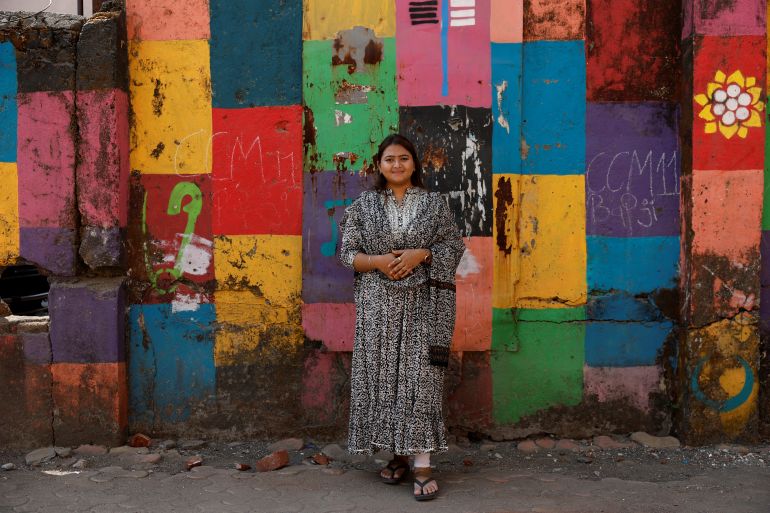
Asma Hamad Shaikh, 23, a teacher and first-time voter, poses for a photograph in Dharavi, Mumbai. ‘I believe that everyone should be educated, illiteracy should be wiped out completely. I hope with a change of government the caste system can be abolished,’ she said. ‘I see a lot of fights between Hindus and Muslims, I didn’t see this division growing up. It’s only in the last few years that it is become a lot’ [Francis Mascarenhas/Reuters] 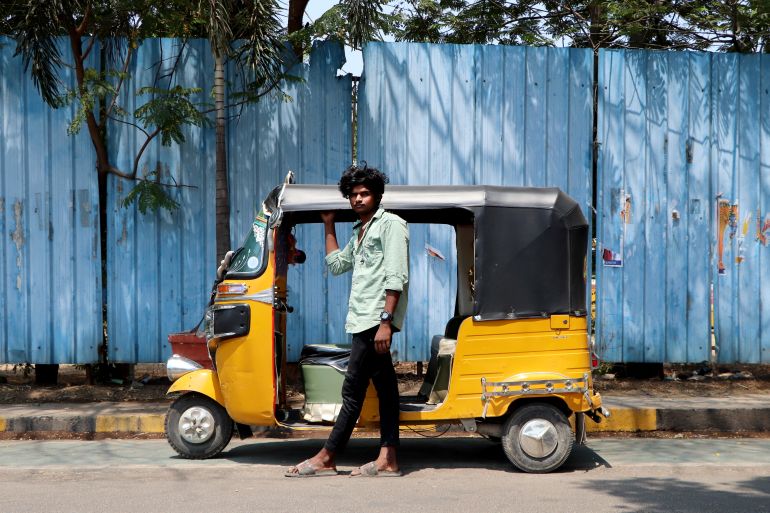
Katravath Santosh, 21, an autorickshaw driver and first-time voter in Hyderabad. ‘Life was better in the earlier government’s term, our livelihood has been impacted. I have studied until 10th standard only, I had to drop out to support my family financially,’ said Katravath. ‘After moving to the city, we are drowning in loans, we were confident we would somehow survive, but we are so sceptical of our futures now’ [Almaas Masood/Reuters] Check out our photo gallery here.
- 16h ago(05:30 GMT)
Congress urges voters to end ‘hatred and injustice’
The main opposition Congress party has urged voters to end “hatred and injustice” as polls opened in the marathon election.
“Your one vote can put an end to inflation, unemployment, hatred and injustice,” the Congress party said on social media platform X, adding: “Make sure to vote.”
- 16h ago(05:20 GMT)
‘Every vote counts and every voice matters’: Modi
“I urge all those voting … to exercise their franchise in record numbers,” Modi posted on X, minutes before polling began.
“I particularly call upon the young and first time voters to vote in large numbers. After all, every vote counts and every voice matters,” he said.
India elections: Modi seeks third term with populist appeals - 17h ago(05:00 GMT)
WATCH: The Indian political ads flouting social media AI rules
Propaganda images created using AI are spreading across social media ahead of India’s looming election – many in a way that flouts platforms’ rules on political advertising.
Watch our video report below:
The Indian political ads flouting social media AI rules - 17h ago(04:45 GMT)
Hindu temple at the heart of Modi’s re-election bid
By Sanjay Kapoor
The grand temple, dedicated to Lord Ram and inaugurated in January this year, has been built on the ruins of a Mughal-era mosque demolished by a Hindu mob in 1992.
The Ram Mandir, as the temple is called, is close to the site that is believed by many Hindus to be Ram’s birthplace.
In the late 1980s, the BJP and its right-wing allies and religious groups launched a massive campaign for the temple, catapulting the BJP from two seats then to a dominant political player now.
Read more here.
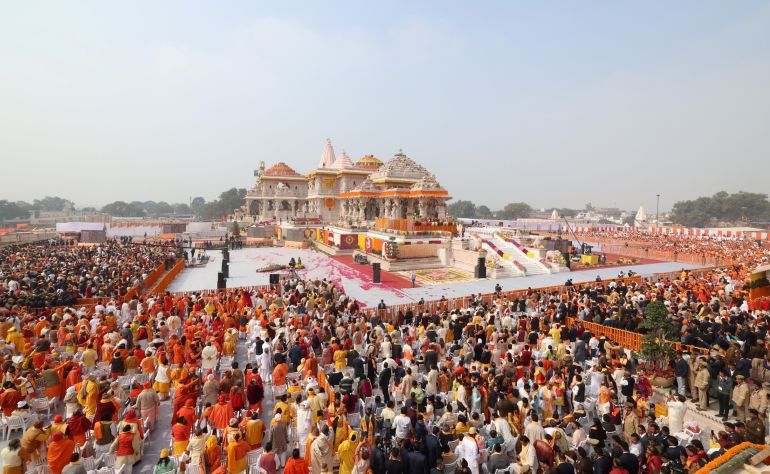
A view during the opening of the grand temple in Ayodhya on January 22 [Handout/India’s Press Information Bureau via Reuters] - 17h ago(04:30 GMT)
WATCH: Who are the opposition fighting to stop another Modi win?
An opposition coalition of 26 parties, including Rahul Gandhi’s Congress, is trying to stop another victory for Modi’s BJP.
But as Indian news editor Seema Chisti explains, convincing voters isn’t the only challenge they face.
Watch our video below:
Who are India’s opposition fighting to stop another Modi win? - 17h ago(04:20 GMT)
Besides BJP and Congress, what other parties are in the fray?
Other main political parties include the Aam Aadmi Party (AAP), the Dravida Munnetra Kazhagam (DMK) and the All India Trinamool Congress (TMC).
AAP governs the states of Delhi and Punjab, and the DMK is in power in Tamil Nadu, while the TMC rules over West Bengal.
Find more about them here.
- 18h ago(04:10 GMT)
The arduous journeys to reach every voter
In 2019, when India last held general elections, a team of polling officers trekked more than 480km (300 miles) for four days just so a single voter in a hamlet in the remote state of Arunachal Pradesh, which borders China, could exercise their voting right.
Officials also travelled to a village tucked away high up in the Himalayas to install a booth at 15,256 feet (4,650 metres), the highest polling station anywhere in the world.
This time too, polling stations will be installed in remote places, including one inside a wildlife sanctuary in southern Kerala state and another in a shipping container in western Gujarat state.
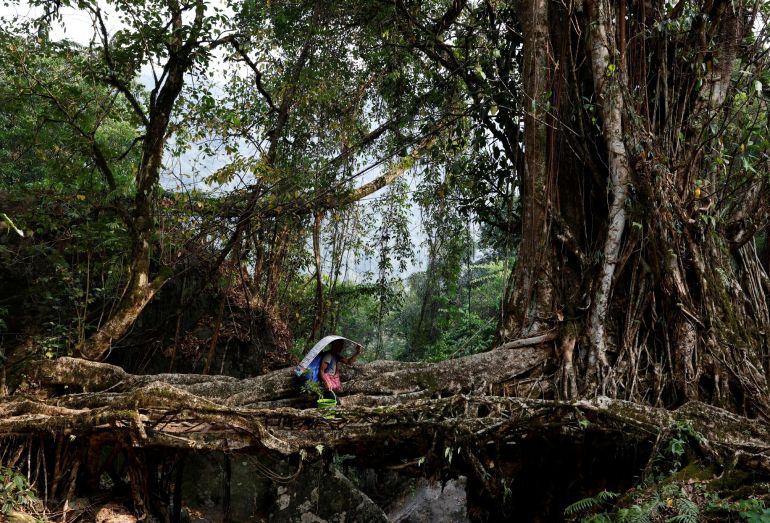
Porter Stanley Mawa carries election material as he crosses a root bridge to reach a remote polling station in Shillong, in the northeastern state of Meghalaya, on April 17 [Adnan Abidi/Reuters] - 18h ago(04:00 GMT)
Will Modi win 400 seats in India’s election?
By Sanjay Kapoor
Southern India, which has traditionally been immune to the BJP’s charms, holds the answer.
Home to about 20 percent of India’s population, the five southern states of Tamil Nadu, Karnataka, Andhra Pradesh, Kerala and Telangana, and the union territories of Puducherry and Lakshadweep, are also India’s most economically prosperous region, contributing more than 30 percent of the country’s gross domestic product.
But despite Modi’s claims of boosting the economy, the BJP won just 30 of the 131 seats from the region – most of them from Karnataka – in 2019. It drew a blank in Tamil Nadu, Kerala and Andhra Pradesh, and lost the constituencies of Puducherry and Lakshadweep.
Some analysts believe a repeat is inevitable this year.
Read more here.
- 18h ago(03:50 GMT)
What are the main issues?
The BJP and its allies have based their campaign on the claim that Modi has changed India’s global image since taking office a decade ago.
They also point to increased income generation and inflation kept in check during times of worldwide economic turmoil and rapid infrastructure development.
The INDIA alliance, meanwhile, has countered with criticism focusing on rising unemployment and corruption in the country while also challenging the government’s statements on inflation data.
Attacks on minorities, mainly Muslims, since Modi’s rise to power and an alleged gag on free speech and media are also among the issues likely to affect the elections.
India’s election explained | Start Here - 18h ago(03:40 GMT)
Why do India’s elections take so long?
It boils down to two key reasons: the sheer size of India, the world’s most populous country, and the astonishing level of logistics needed to ensure that every registered voter is able to cast a ballot.
Over the years, the duration of voting has wavered. It took nearly four months to complete the vote in India’s first election in 1951-1952, after it gained independence from British rule, and just four days in 1980. In 2019, voting took 39 days.
Experts say a key reason behind multiphase elections is security. Tens of thousands of federal security forces, who usually guard borders, for instance, are freed up and deployed alongside state police to prevent violence and transport electoral officials and voting machines.
Modi’s opponents also say a long election gives him an advantage as it makes it easier for the prime minister to travel and campaign, especially in states where his Bharatiya Janata Party (BJP) is weak.
- 18h ago(03:30 GMT)
Which parties are standing against BJP?
The polls are primarily a battle between the NDA, led by Modi’s BJP, and the opposition alliance called INDIA, headed by Congress.
Last time, the BJP swept the elections with 303 seats, while Congress ended with a paltry 52. Modi has set a target of 370 seats for the BJP and more than 400 for the NDA.
The opposition alliance has managed to put up a candidate in many constituencies but faces challenges in keeping a united front.
One of its key members, the All-India Trinamool Congress, which rules eastern West Bengal, has ruled out any seat sharing in the state.
As things stand, most surveys and opinion polls have the BJP as the clear favourite.
You can find out more in this comprehensive piece by the Al Jazeera Explainers team.
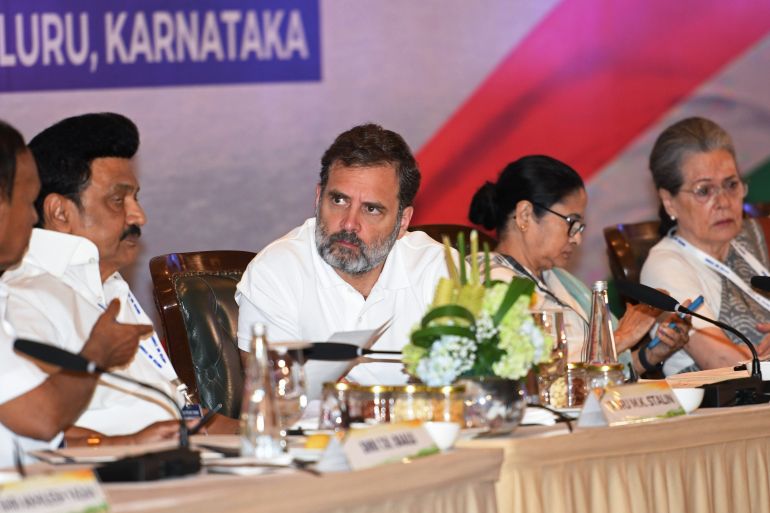
MK Stalin, chief minister of Tamil Nadu, Congress leader Rahul Gandhi, West Bengal chief minister Mamata Banerjee and senior Congress leader Sonia Gandhi at a meeting in Bengaluru [File: Mohan Kumar/AFP] - 18h ago(03:15 GMT)
Why is the election important?
Modi is chasing a record-equalling third straight term like India’s first prime minister, Jawaharlal Nehru. The incumbent says another overwhelming victory for his BJP is crucial to meet his goal of lifting India to a developed economy by 2047 from middle-income levels.
The BJP draws its support mainly from Hindus, who form 80 percent of the country’s 1.42 billion people and for whom Modi earlier this year delivered on a key party promise of building a grand Hindu temple on a disputed site.
The opposition INDIA alliance, largely a centre-left grouping of more than two dozen disparate parties, says a victory for it is essential to save the country’s democratic and secular setup, lift its marginalised communities, raise prices for farmers and create jobs for its young.
Opinion polls, which have a mixed record in India, predict another thrashing of the Congress-led alliance at the hands of the BJP.
- 19h ago(03:00 GMT)
Can India’s election be rigged?
It’s a debate that gets a new life during every national or provincial election in India since the EVMs were implemented in 2000.
Opposition parties have questioned the reliability of the machines, alleging they can be hacked. They say PM Narendra Modi’s BJP owes its electoral dominance to that malpractice, even though multiple opinion polls suggest the party is resoundingly the favourite among voters in many parts of the country.
The charge isn’t new. The Congress and some other opposition parties have previously also questioned the trustworthiness of EVMs, machines that are not connected to the internet yet run on chips that critics say could, in theory, be programmed to record votes in a way that doesn’t match the buttons that voters press.
The election commission and the Supreme Court have rubbished these allegations and no conclusive evidence has emerged yet to substantiate the claims.
Read more here.
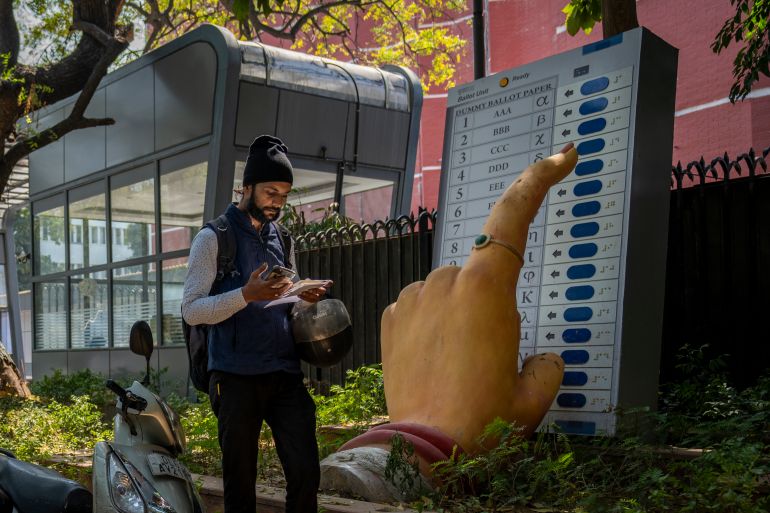
A resident walks past a large model of an EVM in New Delhi [File: Altaf Qadri/AP Photo]i)
9h ago(02:45 GMT) What is an EVM?
It’s a thick, rectangular device used to electronically record votes cast in elections. Voters need to press one of the blue buttons placed against the serial number, name and symbol of the candidate of their choice, apart from the option of “none of the above”.
An EVM has three units – a ballot unit, a control unit for the officer in charge to ensure a voter is able to vote only once, and a voter-verifiable-paper-audit-trail (VVPAT) unit, which produces a paper slip that is visible to the voter via a transparent screen for about seven seconds before it gets stored in a sealed drop box.
The control unit is placed next to the officer in charge while the other two units are kept in a voting compartment for voters to make their choices privately. The whole setup is without any wired or wireless connectivity outside the system.
Each ballot unit can include 16 candidate options including “none of the above”. A total of 24 such units can be connected to a control unit, which means that one unit can accommodate up to 384 candidates, should there be so many candidates from one seat.
An EVM system, which can record up to 2,000 votes, runs on batteries or power packs supplied by its makers, government-run Bharat Electronics Ltd BAJE.NS and Electronics Corp of India.
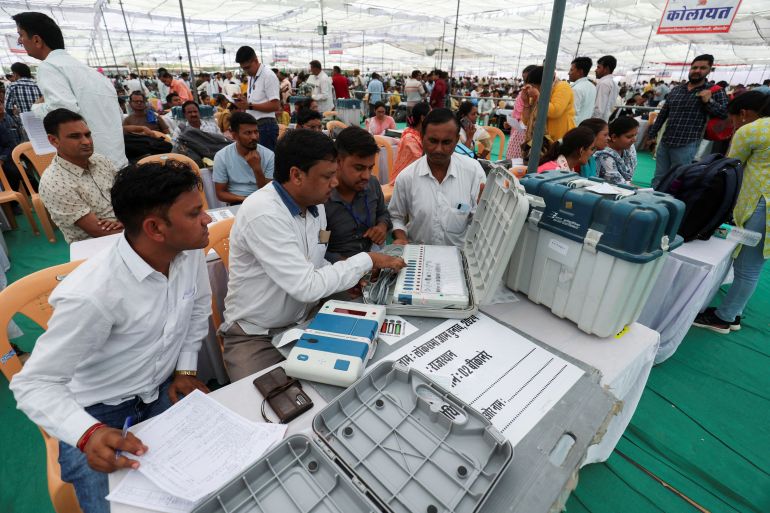
Election staff check an EVM at a polling station in Bikaner, Rajasthan for the election [Amit Dave /Reuters] - 19h ago(02:30 GMT)
How do people vote?
The Election Commission of India, which oversees the polls, has to make sure there is a voting booth available within 2km (1.2 miles) of every voter.
India uses electronic voting machines that allow for faster counting of ballots. The commission says there is no way to connect to the machines remotely and no way to compromise the results.
Election officials travel by foot, road, trains, helicopters, boats and occasionally camels and elephants to set up polling stations in remote locations. They are sometimes accompanied by security forces in areas with a history of political violence.
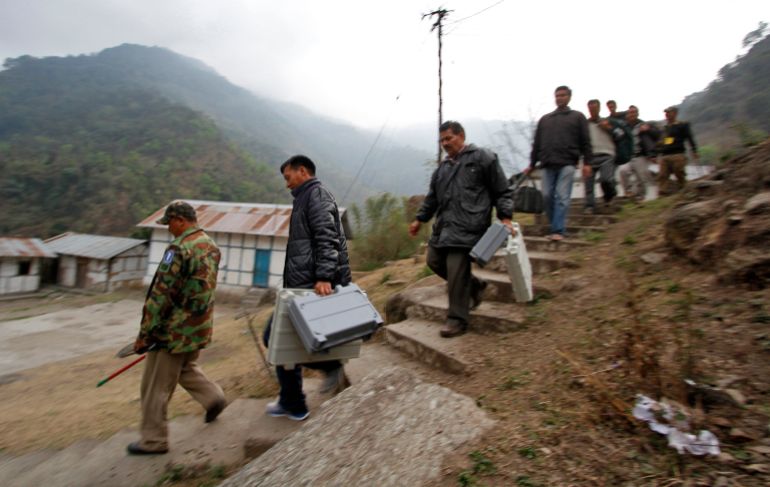
Electoral staff carry electronic voting machines to a polling centre at Kaspi village, in the northeastern Indian state of Arunachal Pradesh, during the 2014 election [Utpal Baruah/Reuters] - 20h ago(02:15 GMT)
Who is voting in phase one?
A total of 102 constituencies across 21 states are voting today.
Keep an eye out for Coimbatore in the southern Tamil Nadu state, Muzaffarnagar in Uttar Pradesh, Maharashtra’s Nagpur and both the parliamentary seats in the restive northeastern state of Manipur – these are some of the important constituencies heading to the polls in this first phase.

- 20h ago(02:00 GMT)
Just how big is India’s election?
From the Himalayas in the north to the Indian Ocean in the south, from the hills of the east to the deserts in the west, and in concrete jungles that are some of the world’s biggest cities to the smallest of villages, an estimated 969 million voters are eligible to cast their ballots.
Voting will run in seven phases – from today to June 1 – while the counting of votes will take place on June 4.
Assembly elections for the states of Andhra Pradesh, Arunachal Pradesh, Odisha and Sikkim will also take place along with the national vote.
Here are seven ways to understand the colossal, colourful and complex election.
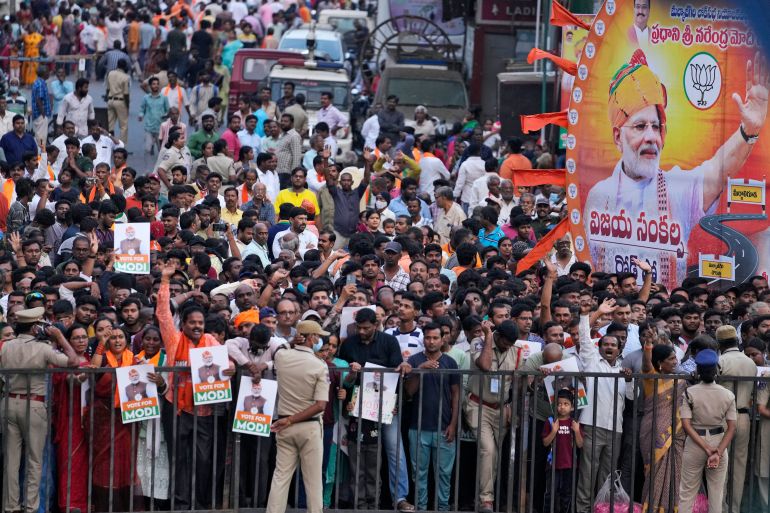
Supporters wait for Prime Minister Narendra Modi to arrive at the venue of a BJP election campaign rally in Hyderabad on March 15 [Mahesh Kumar A/AP Photo] - 20h ago(01:45 GMT)
What are the voting hours?
Voting started at 7am local time (01:30 GMT) and will end at 6pm local time (12:30 GMT). People in the queue by closing time get to vote even if that means keeping polling booths open longer.
With 969 million registered voters, the size of India’s electorate is bigger than the combined population of the 27 European Union member states. This includes 18 million first-time voters, and some 197 million who are in their 20s.
Turnout during the last national elections was more than 67 percent, with nearly 615 million people casting a ballot.
![[Al Jazeera]](https://www.aljazeera.com/wp-content/uploads/2024/03/INTERACTIVE_INDIA_ELECTION_MAR16_2024_1-copy-4-1710309759.png?w=770&resize=770%2C770&quality=80)
[Al Jazeera] - 20h ago(01:31 GMT)
Welcome to our live coverage
Hello and thank you for joining us as polls open in India’s multiphase elections.
Stay with the Al Jazeera Live team as we bring you all the latest developments, analysis and much more throughout the day.
Comments
Post a Comment